Mathematical constant
A mathematical constant is a special number, usually a real number, that is "significantly interesting in some way".[1] Constants arise in many areas of mathematics, with constants such as e and π occurring in such diverse contexts as geometry, number theory, and calculus.
What it means for a constant to arise "naturally", and what makes a constant "interesting", is ultimately a matter of taste, and some mathematical constants are notable more for historical reasons than for their intrinsic mathematical interest. The more popular constants have been studied throughout the ages and computed to many decimal places.
All mathematical constants are definable numbers and usually are also computable numbers (Chaitin's constant being a significant exception).
Common mathematical constants
These are constants which one is likely to encounter during pre-college education in many countries.
Archimedes' constant π

The constant π (pi) has a natural definition in Euclidean geometry (the ratio between the circumference and diameter of a circle), but may be found in many places in mathematics: for example, the Gaussian integral in complex analysis, the roots of unity in number theory, and Cauchy distributions in probability. However, its universality is not limited to pure mathematics. Indeed, various formulae in physics, such as Heisenberg's uncertainty principle, and constants such as the cosmological constant include the constant π. The presence of π in physical principles, laws and formulae can have very simple explanations. For example, Coulomb's law, describing the inverse square proportionality of the magnitude of the electrostatic force between two electric charges and their distance, states that, in SI units,
Besides corresponding to the dielectric constant in vacuum, the factor in the above denominator expresses directly the surface of a sphere with radius r, having thus a very concrete meaning.
The numeric value of π is approximately 3.1415926535. Memorizing increasingly precise digits of π is a world record pursuit.
Euler's number e

Euler's number e, also known as the exponential growth constant, appears in many areas of mathematics, and one possible definition of it is the value of the following expression:
For example, the Swiss mathematician Jacob Bernoulli discovered that e arises in compound interest: An account that starts at $1, and yields interest at annual rate R with continuous compounding, will accumulate to eR dollars at the end of one year. The constant e also has applications to probability theory, where it arises in a way not obviously related to exponential growth. Suppose that a gambler plays a slot machine with a one in n probability of winning, and plays it n times. Then, for large n (such as a million) the probability that the gambler will win nothing at all is approximately 1/e and tends to this value as n tends to infinity.
Another application of e, discovered in part by Jacob Bernoulli along with French mathematician Pierre Raymond de Montmort, is in the problem of derangements, also known as the hat check problem.[3] Here n guests are invited to a party, and at the door each guest checks his hat with the butler who then places them into labelled boxes. The butler does not know the name of the guests, and so must put them into boxes selected at random. The problem of de Montmort is: what is the probability that none of the hats gets put into the right box. The answer is
and as n tends to infinity, pn approaches 1/e.
The numeric value of e is approximately 2.71828.
Pythagoras' constant √2
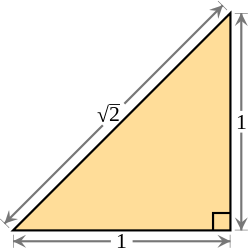
The square root of 2, often known as root 2, radical 2, or Pythagoras's constant, and written as √2, is the positive algebraic number that, when multiplied by itself, gives the number 2. It is more precisely called the principal square root of 2, to distinguish it from the negative number with the same property.
Geometrically the square root of 2 is the length of a diagonal across a square with sides of one unit of length; this follows from the Pythagorean theorem. It was probably the first number known to be irrational. Its numerical value truncated to 65 decimal places is:
- 1.41421356237309504880168872420969807856967187537694807317667973799... (sequence A002193 in the OEIS).
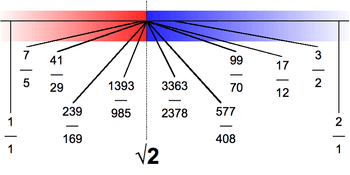
The quick approximation 99/70 (≈ 1.41429) for the square root of two is frequently used. Despite having a denominator of only 70, it differs from the correct value by less than 1/10,000 (approx. 7.2 × 10 −5).
The imaginary unit i

The imaginary unit or unit imaginary number, denoted as i, is a mathematical concept which extends the real number system ℝ to the complex number system ℂ, which in turn provides at least one root for every polynomial P(x) (see algebraic closure and fundamental theorem of algebra). The imaginary unit's core property is that i2 = −1. The term "imaginary" is used because there is no real number having a negative square.
There are in fact two complex square roots of −1, namely i and −i, just as there are two complex square roots of every other real number, except zero, which has one double square root.
In contexts where i is ambiguous or problematic, j or the Greek ι (see alternative notations) is sometimes used. In the disciplines of electrical engineering and control systems engineering, the imaginary unit is often denoted by j instead of i, because i is commonly used to denote electric current in these disciplines.
Constants in advanced mathematics
These are constants which are encountered frequently in higher mathematics.
The Feigenbaum constants α and δ
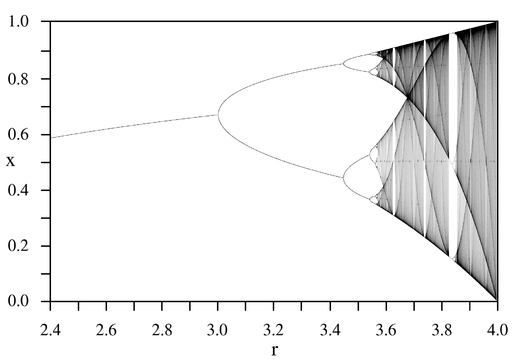
Iterations of continuous maps serve as the simplest examples of models for dynamical systems.[4] Named after mathematical physicist Mitchell Feigenbaum, the two Feigenbaum constants appear in such iterative processes: they are mathematical invariants of logistic maps with quadratic maximum points[5] and their bifurcation diagrams.
The logistic map is a polynomial mapping, often cited as an archetypal example of how chaotic behaviour can arise from very simple non-linear dynamical equations. The map was popularized in a seminal 1976 paper by the Australian biologist Robert May,[6] in part as a discrete-time demographic model analogous to the logistic equation first created by Pierre François Verhulst. The difference equation is intended to capture the two effects of reproduction and starvation.
The numeric value of α is approximately 2.5029. The numeric value of δ is approximately 4.6692.
Apéry's constant ζ(3)
Despite being a special value of the Riemann zeta function, Apéry's constant arises naturally in a number of physical problems, including in the second- and third-order terms of the electron's gyromagnetic ratio, computed using quantum electrodynamics.[7] The numeric value of ζ(3) is approximately 1.2020569.
The golden ratio φ

The number φ, also called the golden ratio, turns up frequently in geometry, particularly in figures with pentagonal symmetry. Indeed, the length of a regular pentagon's diagonal is φ times its side. The vertices of a regular icosahedron are those of three mutually orthogonal golden rectangles. Also, it appears in the Fibonacci sequence, related to growth by recursion.[8] Kepler proved that it is the limit of the ratio of consecutive Fibonacci numbers.[9] The golden ratio has the slowest convergence of any irrational number.[10] It is, for that reason, one of the worst cases of Lagrange's approximation theorem and it is an extremal case of the Hurwitz inequality for Diophantine approximations. This may be why angles close to the golden ratio often show up in phyllotaxis (the growth of plants).[11] It is approximately equal to 1.6180339887498948482, or, more precisely 2sin(54°) =
The Euler–Mascheroni constant γ
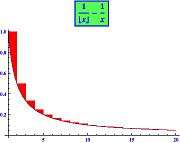
The Euler–Mascheroni constant is a recurring constant in number theory. The Belgian mathematician Charles Jean de la Vallée-Poussin proved in 1898 that when taking any positive integer n and dividing it by each positive integer m less than n, the average fraction by which the quotient n/m falls short of the next integer tends to as n tends to infinity. Surprisingly, this average doesn't tend to one half. The Euler–Mascheroni constant also appears in Merten's third theorem and has relations to the gamma function, the zeta function and many different integrals and series. The definition of the Euler–Mascheroni constant exhibits a close link between the discrete and the continuous (see curves on the left).
The numeric value of is approximately 0.57721.
Conway's constant λ
Conway's constant is the invariant growth rate of all derived strings similar to the look-and-say sequence (except for one trivial one).[12]
It is given by the unique positive real root of a polynomial of degree 71 with integer coefficients.[12]
The value of λ is approximately 1.30357.
Khinchin's constant K
If a real number r is written as a simple continued fraction:
where ak are natural numbers for all k
then, as the Russian mathematician Aleksandr Khinchin proved in 1934, the limit as n tends to infinity of the geometric mean: (a1a2...an)1/n exists and is a constant, Khinchin's constant, except for a set of measure 0.[13]
The numeric value of K is approximately 2.6854520010.
The Glaisher–Kinkelin constant A
The Glaisher–Kinkelin constant is defined as the limit:
It is an important constant which appears in many expressions for the derivative of the Riemann zeta function. It has a numerical value of approximately 1.2824271291.
Mathematical curiosities and unspecified constants
Simple representatives of sets of numbers

Some constants, such as the square root of 2, Liouville's constant and Champernowne constant:
are not important mathematical invariants but retain interest being simple representatives of special sets of numbers, the irrational numbers,[15] the transcendental numbers[16] and the normal numbers (in base 10)[17] respectively. The discovery of the irrational numbers is usually attributed to the Pythagorean Hippasus of Metapontum who proved, most likely geometrically, the irrationality of the square root of 2. As for Liouville's constant, named after French mathematician Joseph Liouville, it was the first number to be proven transcendental.[18]
Chaitin's constant Ω
In the computer science subfield of algorithmic information theory, Chaitin's constant is the real number representing the probability that a randomly chosen Turing machine will halt, formed from a construction due to Argentine-American mathematician and computer scientist Gregory Chaitin. Chaitin's constant, though not being computable, has been proven to be transcendental and normal. Chaitin's constant is not universal, depending heavily on the numerical encoding used for Turing machines; however, its interesting properties are independent of the encoding.
Unspecified constants
When unspecified, constants indicate classes of similar objects, commonly functions, all equal up to a constant—technically speaking, this is may be viewed as 'similarity up to a constant'. Such constants appear frequently when dealing with integrals and differential equations. Though unspecified, they have a specific value, which often is not important.
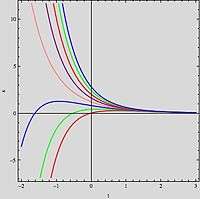
In integrals
Indefinite integrals are called indefinite because their solutions are only unique up to a constant. For example, when working over the field of real numbers
where C, the constant of integration, is an arbitrary fixed real number.[19] In other words, whatever the value of C, differentiating sin x + C with respect to x always yields cos x.
In differential equations
In a similar fashion, constants appear in the solutions to differential equations where not enough initial values or boundary conditions are given. For example, the ordinary differential equation y' = y(x) has solution Cex where C is an arbitrary constant.
When dealing with partial differential equations, the constants may be functions, constant with respect to some variables (but not necessarily all of them). For example, the PDE
has solutions f(x,y) = C(y), where C(y) is an arbitrary function in the variable y.
Notation
Representing constants
It is common to express the numerical value of a constant by giving its decimal representation (or just the first few digits of it). For two reasons this representation may cause problems. First, even though rational numbers all have a finite or ever-repeating decimal expansion, irrational numbers don't have such an expression making them impossible to completely describe in this manner. Also, the decimal expansion of a number is not necessarily unique. For example, the two representations 0.999... and 1 are equivalent[20][21] in the sense that they represent the same number.
Calculating digits of the decimal expansion of constants has been a common enterprise for many centuries. For example, German mathematician Ludolph van Ceulen of the 16th century spent a major part of his life calculating the first 35 digits of pi.[22] Using computers and supercomputers, some of the mathematical constants, including π, e, and the square root of 2, have been computed to more than one hundred billion digits. Fast algorithms have been developed, some of which — as for Apéry's constant — are unexpectedly fast.
Some constants differ so much from the usual kind that a new notation has been invented to represent them reasonably. Graham's number illustrates this as Knuth's up-arrow notation is used.[23][24]
It may be of interest to represent them using continued fractions to perform various studies, including statistical analysis. Many mathematical constants have an analytic form, that is they can be constructed using well-known operations that lend themselves readily to calculation. Not all constants have known analytic forms, though; Grossman's constant[25] and Foias' constant[26] are examples.
Symbolizing and naming of constants
Symbolizing constants with letters is a frequent means of making the notation more concise. A standard convention, instigated by Leonhard Euler in the 18th century, is to use lower case letters from the beginning of the Latin alphabet or the Greek alphabet when dealing with constants in general.
Embree–Trefethen constant
Brun's constant for twin prime
Champernowne constants
cardinal number aleph naught
However, for more important constants, the symbols may be more complex and have an extra letter, an asterisk, a number, a lemniscate or use different alphabets such as Hebrew, Cyrillic or Gothic.[24]
Sometimes, the symbol representing a constant is a whole word. For example, American mathematician Edward Kasner's 9-year-old nephew coined the names googol and googolplex.[24][27]
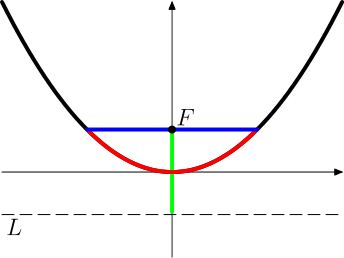
The names are either related to the meaning of the constant (universal parabolic constant, twin prime constant, ...) or to a specific person (Sierpiński's constant, Josephson constant, ...).
Table of selected mathematical constants
Abbreviations used:
- R – Rational number, I – Irrational number (may be algebraic or transcendental), A – Algebraic number (irrational), T – Transcendental number (irrational)
- Gen – General, NuT – Number theory, ChT – Chaos theory, Com – Combinatorics, Inf – Information theory, Ana – Mathematical analysis
| Symbol | Value | Name | Field | N | First described | # of known digits |
|---|---|---|---|---|---|---|
0 |
= 0 | Zero | Gen | R | by c. 500 BC | N/A |
1 |
= 1 | One, Unity | Gen | R | N/A | |
i |
= √–1 | Imaginary unit, unit imaginary number | Gen, Ana | A | by c. 1500 | N/A |
π |
≈ 3.14159 26535 89793 23846 26433 83279 50288 | Pi, Archimedes' constant or Ludolph's number | Gen, Ana | T | by c. 2600 BC | 12,100,000,000,000[28] |
e |
≈ 2.71828 18284 59045 23536 02874 71352 66249 | e, Napier's constant, or Euler's number | Gen, Ana | T | 1618 | 100,000,000,000 |
√2 |
≈ 1.41421 35623 73095 04880 16887 24209 69807 | Pythagoras' constant, square root of 2 | Gen | A | by c. 800 BC | 137,438,953,444 |
√3 |
≈ 1.73205 08075 68877 29352 74463 41505 87236 | Theodorus' constant, square root of 3 | Gen | A | by c. 800 BC | |
√5 |
≈ 2.23606 79774 99789 69640 91736 68731 27623 | square root of 5 | Gen | A | by c. 800 BC | |
| ≈ 0.57721 56649 01532 86060 65120 90082 40243 | Euler–Mascheroni constant | Gen, NuT | 1735 | 14,922,244,771 | ||
| ≈ 1.61803 39887 49894 84820 45868 34365 63811 | Golden ratio | Gen | A | by c. 200 BC | 100,000,000,000 | |
| ≥ –1.1 • 10−12 | de Bruijn–Newman constant | NuT | 1950 ? | none | ||
M1 |
≈ 0.26149 72128 47642 78375 54268 38608 69585 | Meissel–Mertens constant | NuT | 1866 1874 |
8,010 | |
| ≈ 0.28016 94990 23869 13303 | Bernstein's constant[29] | Ana | ||||
| ≈ 0.30366 30028 98732 65859 74481 21901 55623 | Gauss–Kuzmin–Wirsing constant | Com | 1974 | 385 | ||
| ≈ 0.35323 63718 54995 98454 35165 50432 68201 | Hafner–Sarnak–McCurley constant | NuT | 1993 | |||
L |
≈ 0.5 | Landau's constant | Ana | 1 | ||
Ω |
≈ 0.56714 32904 09783 87299 99686 62210 35555 | Omega constant | Ana | T | ||
, |
≈ 0.62432 99885 43550 87099 29363 83100 83724 | Golomb–Dickman constant | Com, NuT | 1930 1964 |
||
| ≈ 0.64341 05463 | Cahen's constant | T | 1891 | 4000 | ||
C2 |
≈ 0.66016 18158 46869 57392 78121 10014 55577 | Twin prime constant | NuT | 5,020 | ||
| ≈ 0.66274 34193 49181 58097 47420 97109 25290 | Laplace limit | |||||
* |
≈ 0.70258 | Embree–Trefethen constant | NuT | |||
K |
≈ 0.76422 36535 89220 66299 06987 31250 09232 | Landau–Ramanujan constant | NuT | 30,010 | ||
| ≈ 0.80939 40205 | Alladi–Grinstead constant[30] | NuT | ||||
B4 |
≈ 0.87058 83800 | Brun's constant for prime quadruplets | NuT | |||
K |
≈ 0.91596 55941 77219 01505 46035 14932 38411 | Catalan's constant | Com | 15,510,000,000 | ||
B´L |
= 1 | Legendre's constant | NuT | R | N/A | |
| ≈ 1.09868 58055 | Lengyel's constant[31] | Com | 1992 | |||
K |
≈ 1.13198 824 | Viswanath's constant | NuT | 8 | ||
| |
≈ 1.20205 69031 59594 28539 97381 61511 44999 | Apéry's constant | I | 1979 | 15,510,000,000 | |
| ≈ 1.30357 72690 34296 39125 70991 12152 55189 | Conway's constant | NuT | A | |||
| ≈ 1.30637 78838 63080 69046 86144 92602 60571 | Mills' constant | NuT | 1947 | 6850 | ||
| ≈ 1.32471 79572 44746 02596 09088 54478 09734 | Plastic constant | NuT | A | 1928 | ||
| ≈ 1.45136 92348 83381 05028 39684 85892 02744 | Ramanujan–Soldner constant | NuT | I | 75,500 | ||
| ≈ 1.45607 49485 82689 67139 95953 51116 54356 | Backhouse's constant[32] | |||||
| ≈ 1.46707 80794 | Porter's constant[33] | NuT | 1975 | |||
| ≈ 1.53960 07178 | Lieb's square ice constant[34] | Com | A | 1967 | ||
EB |
≈ 1.60669 51524 15291 76378 33015 23190 92458 | Erdős–Borwein constant | NuT | I | ||
| ≈ 1.70521 11401 05367 76428 85514 53434 50816 | Niven's constant | NuT | 1969 | |||
B2 |
≈ 1.90216 05823 | Brun's constant for twin primes | NuT | 1919 | 10 | |
P2 |
≈ 2.29558 71493 92638 07403 42980 49189 49039 | Universal parabolic constant | Gen | T | ||
| ≈ 2.50290 78750 95892 82228 39028 73218 21578 | Feigenbaum constant | ChT | ||||
K |
≈ 2.58498 17595 79253 21706 58935 87383 17116 | Sierpiński's constant | ||||
| ≈ 2.68545 20010 65306 44530 97148 35481 79569 | Khinchin's constant | NuT | 1934 | 7350 | ||
F |
≈ 2.80777 02420 28519 36522 15011 86557 77293 | Fransén–Robinson constant | Ana | |||
| ≈ 3.27582 29187 21811 15978 76818 82453 84386 | Lévy's constant | NuT | ||||
| ≈ 3.35988 56662 43177 55317 20113 02918 92717 | Reciprocal Fibonacci constant[35] | I | ||||
| ≈ 4.66920 16091 02990 67185 32038 20466 20161 | Feigenbaum constant | ChT | 1975 |
See also
Notes
- ↑ Weisstein, Eric W. "Constant". MathWorld. Retrieved April 13, 2011.
- ↑ Weisstein, Eric W. "Sphere". MathWorld.
- ↑ Grinstead, C.M.; Snell, J.L. "Introduction to probability theory". p. 85. Retrieved 2007-12-09.
- ↑ Collet & Eckmann (1980). Iterated maps on the inerval as dynamical systems. Birkhauser. ISBN 3-7643-3026-0.
- ↑ Finch, Steven (2003). Mathematical constants. Cambridge University Press. p. 67. ISBN 0-521-81805-2.
- ↑ May, Robert (1976). Theoretical Ecology: Principles and Applications. Blackwell Scientific Publishers. ISBN 0-632-00768-0.
- ↑ Steven Finch. "Apéry's constant". MathWorld.
- ↑ Livio, Mario (2002). The Golden Ratio: The Story of Phi, The World's Most Astonishing Number. New York: Broadway Books. ISBN 0-7679-0815-5.
- ↑ Tatersall, James (2005). Elementary number theory in nine chapters (2nd ed.
- ↑ "The Secret Life of Continued Fractions"
- ↑ Fibonacci Numbers and Nature - Part 2 : Why is the Golden section the "best" arrangement?, from Dr. Ron Knott's Fibonacci Numbers and the Golden Section, retrieved 2012-11-29.
- 1 2 Steven Finch. "Conway's Constant". MathWorld.
- ↑ Steven Finch. "Khinchin's Constant". MathWorld.
- ↑ Fowler, David; Eleanor Robson (November 1998). "Square Root Approximations in Old Babylonian Mathematics: YBC 7289 in Context" (PDF). Historia Mathematica. 25 (4): 368. doi:10.1006/hmat.1998.2209. Archived from the original (PDF) on 2007-11-28. Retrieved 2007-12-09.
Photograph, illustration, and description of the root(2) tablet from the Yale Babylonian Collection
High resolution photographs, descriptions, and analysis of the root(2) tablet (YBC 7289) from the Yale Babylonian Collection - ↑ Bogomolny, Alexander. "Square root of 2 is irrational".
- ↑ Aubrey J. Kempner (Oct 1916). "On Transcendental Numbers". Transactions of the American Mathematical Society. Transactions of the American Mathematical Society, Vol. 17, No. 4. 17 (4): 476–482. doi:10.2307/1988833. JSTOR 1988833.
- ↑ Champernowne, david (1933). "The Construction of Decimals Normal in the Scale of Ten". Journal of the London Mathematical Society. 8 (4): 254–260. doi:10.1112/jlms/s1-8.4.254.
- ↑ Weisstein, Eric W. "Liouville's Constant". MathWorld.
- ↑ Edwards, Henry; David Penney (1994). Calculus with analytic geometry (4e ed.). Prentice Hall. p. 269. ISBN 0-13-300575-5.
- ↑ Rudin, Walter (1976) [1953]. Principles of mathematical analysis (3e ed.). McGraw-Hill. p.61 theorem 3.26. ISBN 0-07-054235-X.
- ↑ Stewart, James (1999). Calculus: Early transcendentals (4e ed.). Brooks/Cole. p. 706. ISBN 0-534-36298-2.
- ↑ Ludolph van Ceulen – biography at the MacTutor History of Mathematics archive.
- ↑ Knuth, Donald (1976). "Mathematics and Computer Science: Coping with Finiteness. Advances in Our Ability to Compute are Bringing Us Substantially Closer to Ultimate Limitations". Science. 194 (4271): 1235–1242. doi:10.1126/science.194.4271.1235. PMID 17797067.
- 1 2 3 "mathematical constants". Retrieved 2007-11-27.
- ↑ Weisstein, Eric W. "Grossman's constant". MathWorld.
- ↑ Weisstein, Eric W. "Foias' constant". MathWorld.
- ↑ Edward Kasner and James R. Newman (1989). Mathematics and the Imagination. Microsoft Press. p. 23.
- ↑ Pi Computation Record
- ↑ Weisstein, Eric W. "Bernstein's Constant". MathWorld.
- ↑ Weisstein, Eric W. "Alladi–Grinstead Constant". MathWorld.
- ↑ Weisstein, Eric W. "Lengyel's Constant". MathWorld.
- ↑ Weisstein, Eric W. "Backhouse's Constant". MathWorld.
- ↑ Weisstein, Eric W. "Porter's Constant". MathWorld.
- ↑ Weisstein, Eric W. "Lieb's Square Ice Constant". MathWorld.
- ↑ Weisstein, Eric W. "Reciprocal Fibonacci Constant". MathWorld.
External links
- Constants – from Wolfram MathWorld
- Inverse symbolic calculator (CECM, ISC) (tells you how a given number can be constructed from mathematical constants)
- On-Line Encyclopedia of Integer Sequences (OEIS)
- Simon Plouffe's inverter
- Steven Finch's page of mathematical constants (BROKEN LINK)
- Steven R. Finch, "Mathematical Constants," Encyclopedia of mathematics and its applications, Cambridge University Press (2003).
- Xavier Gourdon and Pascal Sebah's page of numbers, mathematical constants and algorithms